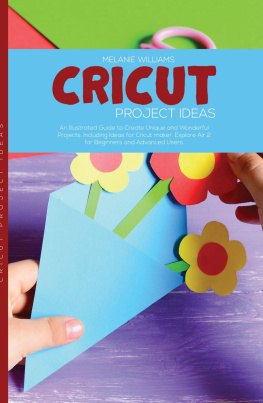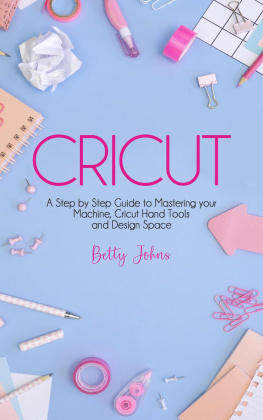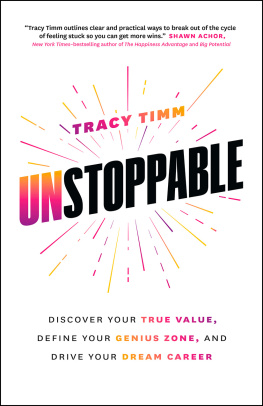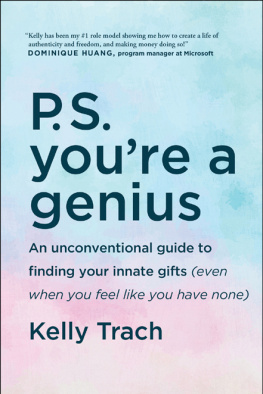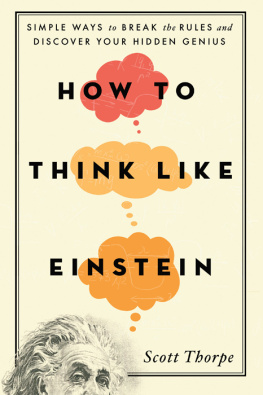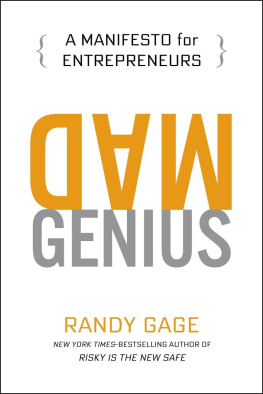T H E G E N I U S
M A C H I N E
T H E G E N I U S
M A C H I N E

G E R A L D S I N D E L L

New World Library
Novato, California
 | New World Library
14 Pamaron Way
Novato, California 94949 |
Copyright by Gerald Sindell
All rights reserved. This book may not be reproduced in whole or in part, stored in a retrieval system, or transmitted in any form or by any means electronic, mechanical, or other without written permission from the publisher, except by a reviewer, who may quote brief passages in a review.
Text design by Tona Pearce Myers
Library of Congress Cataloging-in-Publication Data Sindell, Gerald Seth. The genius machine : the eleven steps that turn raw ideas into brilliance
/ Gerald Sindell.
p. cm.
Includes index.
ISBN 978-1-57731-650-3 (hardcover : alk. paper)
1. New products. 2. Product management. 3. Marketing. 4. Critical
thinkingPopular works. I. Title.
HF5415.153S57 2009
658.5'75dc22 2009002429
First printing, April 2009
ISBN 978-1-57731-650-3
Printed in Canada on 100% postconsumer-waste recycled paper
 | New World Library is a proud member of the Green Press Initiative. |
10 9 8 7 6 5 4 3 2 1
For Leanne, beloved muse, mate, partner, agent


M y work is to help people think. My clients write books, create innovative solutions, develop brilliant breakthroughs, and endeavor to make the world a better place.
One of the great challenges in getting new and valuable ideas accepted is that many intended users, even those who would benefit enormously from what is being offered, spend a lot of energy and time trying to figure out who the person is behind the innovation. Until we feel comfortable that we know the answer, its hard for us to accept advice, no matter how valuable it might be. I often suggest to my clients that they help their intended users get past this barrier by being as explicit about themselves as they can be, as soon as they can. This goes for companies too. Were Acme, we stand for discovering the colors that will bring joy to your life. Okay, got it: Acme equals colors of joy. Now I can forget about you and look at your palette.
So lets get me out of the way: Im a guy in my early sixties who was in the film business for the first decade and a half of his professional life, who then migrated to book publishing. In film, as a director, writer, and editor, I learned about pacing and storytelling. And as an entrepreneur, I learned about being creative on time and within a budget.
When my brother and I made our first full-length feature motion picture, Double-Stop, I was constantly haunted by the fear that the moment we finished the films principal photography, and the cast and crew dispersed, I would suddenly come up with some brilliant idea that should have been part of the movie but now never could be. That concern stayed with me, and it guides all the intellectual property development I engage in, including the development of this book. We must have our brilliant ideas now, in the development stage. Fully developing our best ideas after our work has gone into production or to market is way too late.
I also learned how to market movies from some of the best people in the business. As a publisher and book developer, I employed those same skills to help authors become better storytellers, and to find better ways to get new and valuable information into the marketplace of ideas.
During the last twenty years of working with business leaders to build their personal reputations, and to enhance the profile of their organizations, I created a system for developing intellectual property ideas. Not long ago a number of my clients turned the tables on me and suggested I take a little of my own medicine and organize my methodology. I eventually distilled my process down to eleven essential steps. I wrote a draft outline and circulated it among many of my clients, asking if it captured what they had found valuable. With their comments and further refinement, that system is what you now hold in your hands. I call it the Endleofon (END-leo-fahn), an old English word for eleven, and some of my clients call it the Genius Machine.
Using this process, I have helped dozens of authors create books that have sold many millions of copies. I have helped leaders in many fields learn to articulate their core knowledge so they could better share it with others. Recently I worked with one of the top two Internet companies to help them complete the development of a core knowledge area, and to turn that into a book that may soon help millions of people all over the globe. Whats so good about the Endleofon system? Its fast, its complete, it helps people quickly get to the bottom of what they need to think through, and it anticipates the outreach part of innovation at the very beginning. It is not unusual for an individual or group working with the process to suddenly realize that they can speed through a development cycle in days, not months or years. And with the Endleofon, innovations are always developed with the understanding that its tough to get new ideas accepted.
What else do you need to know about me so we can get started? Simply, I am driven to deliver valuable knowledge and ideas to the people who would benefit from that knowledge. Whether this means a subsistence farmer trying to increase his yield, a Swiss banker needing a fresh view of the global economy, or a young person anywhere trying to figure out how to plan a satisfying life, I am eager to diffuse ideas and to improve the process of diffusion. The terrible gap that lies between existing knowledge and the persistence of ignorance and its concomitant poverty, illness, and suffering drives me crazy.
Enough about me. Lets start thinking!
What is thinking? Some thinking is actually contemplation thinking about something youd like to eat or a place you might like to visit someday. Some thinking is problem solving two trains, each carrying twelve penguins, leave Philadelphia at the same time traveling in opposite directions. How will the penguins get back in touch?
This book is about a third kind of thinking, one that is directed toward improving an existing idea, thinking through a complete issue, or creating something new. We use this kind of thinking when were designing a house, creating a better way for people in our company to work together, or coming up with a better method for kids to learn something. This kind of thinking is about creating something with a particular goal in mind. If were successful, well have a better toaster, a better company, a better school system, a better way to choose political leaders.
Imagine how the world would be if everyone could be really smart when they needed to be. The best ideas would always be the ones wed choose to use, wed find great solutions for all our problems, organizations would reflect the best values of its employees more often than not, and the world would be one wonderful place to live.


